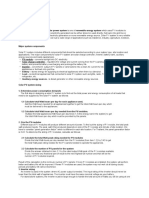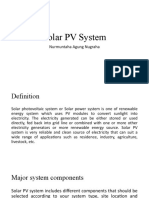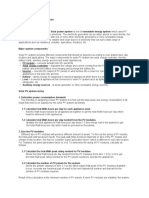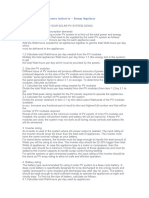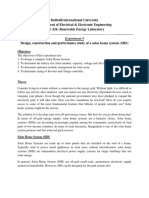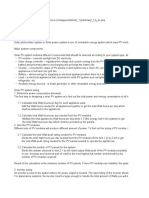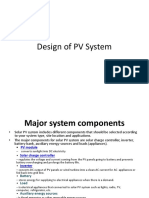0 ratings0% found this document useful (0 votes)
27 viewsSolar Panel
A solar panel consists of multiple solar cells that convert sunlight into electricity. A solar photovoltaic (PV) system uses PV modules to harness solar energy and convert it to electricity. Major components of a solar PV system include PV modules, solar charge controllers, inverters, batteries, and loads. The sizing of a solar PV system involves determining power consumption demands, sizing the PV modules based on watt-hours needed per day, selecting an appropriately sized inverter, and choosing batteries designed for deep cycle use and rapid recharging. Proper sizing and selection of components is necessary for a solar PV system to reliably meet power needs.
Uploaded by
gueshCopyright
© © All Rights Reserved
Available Formats
Download as DOCX, PDF, TXT or read online on Scribd
0 ratings0% found this document useful (0 votes)
27 viewsSolar Panel
A solar panel consists of multiple solar cells that convert sunlight into electricity. A solar photovoltaic (PV) system uses PV modules to harness solar energy and convert it to electricity. Major components of a solar PV system include PV modules, solar charge controllers, inverters, batteries, and loads. The sizing of a solar PV system involves determining power consumption demands, sizing the PV modules based on watt-hours needed per day, selecting an appropriately sized inverter, and choosing batteries designed for deep cycle use and rapid recharging. Proper sizing and selection of components is necessary for a solar PV system to reliably meet power needs.
Uploaded by
gueshCopyright
© © All Rights Reserved
Available Formats
Download as DOCX, PDF, TXT or read online on Scribd
You are on page 1/ 3
Solar panel
The Solar energy is a renewable source of energy which is abundantly
available, used for various purposes. A solar panel consists of multiple
solar cells built in series. Solar photovoltaic system or solar power system
is one of renewable energy system which uses PV modules to convert
sunlight into electricity. The electricity generated can be stored or used
directly, fed back into grid line or combined with one or more other
electricity generators or more renewable energy source. Solar PV system
is very reliable and clean source of electricity that can suit a wide range of
applications such as residence, industry, agriculture, livestock
Major system components
Solar PV system includes different components that should be selected
according to our system type and applications. The major components for
solar PV system are solar charge controller, inverter, battery bank,
auxiliary energy sources and loads (appliances).
PV module: Converts sunlight into DC electricity.
Solar charge controller regulates the voltage and current coming
from the PV panels going to battery and prevents battery
overcharging and prolongs the battery life.
Inverter converts DC output of PV panels or wind turbine into a
clean AC current for AC appliances or fed back into grid line.
Battery stores energy for supplying to electrical appliances when
there is a demand.
Load is electrical appliances that connected to solar PV system
such asmovmont of the machine,
Auxiliary energy sources - is diesel generator or other renewable
energy sources.
Solar PV system sizing
1. Determine power consumption demands
The first step in designing a solar PV system is to find out the total power
and energy consumption of all loads that need to be supplied by the solar
PV system as follows:
1.1 Calculate total Watt-hours per day for each appliance used. Add the
Watt-hours needed for all appliances together to get the total Watt-hours
per day which must be delivered to the appliances.
1.2 Calculate total Watt-hours per day needed from the PV modules.
Multiply the total appliances Watt-hours per day times
1.3 (the energy lost in the system) to get the total Watt-hours per day
which must be provided by the panels.
2. Size the PV modules
Different size of PV modules will produce different amount of power. To
find out the sizing of PV module, the total peak watt produced needs. The
peak watt (Wp) produced depends on size of the PV module and climate of
site location. We have to consider
panel generation factor: which is different in each site location. For
Thailand, the panel generation factor is 3.43. To determine the
sizing of PV modules, calculate as follows:
2.1 Calculate the total Watt-peak rating needed for PV modules Divide the
total Watt-hours per day needed from the PV modules (from item 1.2) by
3.43 to get the total Watt-peak rating needed for the PV panels needed to
operate the appliances.
2.2 Calculate the number of PV panels for the system Divide the answer
obtained in item 2.1 by the rated output Watt-peak of the PV modules
available to you. Increase any fractional part of result to the next highest
full number and that will be the number of PV modules required.
Result of the calculation is the minimum number of PV panels. If more PV
modules are installed, the system will performbetter and battery life will
be improved. If fewer PV modules are used, the system may not work at
all during cloudyperiods and battery life will be shortened
.3. Inverter sizing
An inverter is used in the system where AC power output is needed. The
input rating of the inverter should never belower than the total watt of
appliances. The inverter must have the same nominal voltage as your
battery.
For stand-alone systems, the inverter must be large enough to handle the
total amount of Watts you will be using at onetime. The inverter size
should be 25-30% bigger than total Watts of appliances. In case of
appliance type is motor orcompressor then inverter size should be
minimum 3 times the capacity of those appliances and must be added to
theinverter capacity to handle surge current during starting.
For grid tie systems or grid connected systems, the input rating of the
inverter should be same as PV array rating toallow for safe and efficient
operation.
4. Battery sizing
The battery type recommended for using in solar PV system is deep cycle
battery. Deep cycle battery is specificallydesigned for to be discharged to
low energy level and rapid recharged or cycle charged and discharged
day after day foryears. The battery should be large,
Selection of batteries
The use of batteries is indispensable in stand-alone photovoltaic (PV)
systems, and the physical integration of a battery pack and a PV panel in
one device enables this concept while easing the installation and system
scaling. A battery is a device that stores energy and then discharges it by converting chemical
energy into electricity.
You might also like
- Solar PV System: Nurmuntaha Agung NugrahaNo ratings yetSolar PV System: Nurmuntaha Agung Nugraha21 pages
- How To Design and Calculate Solar Street Light System - PDF100% (2)How To Design and Calculate Solar Street Light System - PDF9 pages
- Design of PV System (Lecture Format) - 1No ratings yetDesign of PV System (Lecture Format) - 134 pages
- New Approach in Size Optimization and Performance Prediction Photovoltaic Hybrid Power SystemsNo ratings yetNew Approach in Size Optimization and Performance Prediction Photovoltaic Hybrid Power Systems4 pages
- Design and Installation of Solar PV SystemsNo ratings yetDesign and Installation of Solar PV Systems8 pages
- Lecture 6 Dimensioning of Off-Grid PV SystemsNo ratings yetLecture 6 Dimensioning of Off-Grid PV Systems24 pages
- What Is A Solar Power Plant? How Does It Work?No ratings yetWhat Is A Solar Power Plant? How Does It Work?2 pages
- Renewable Energy-Design Concepts & Implementation: Engr. Nwafor Chukwubuikem MichaelNo ratings yetRenewable Energy-Design Concepts & Implementation: Engr. Nwafor Chukwubuikem Michael20 pages
- Design and Installation of Solar PV SystemsNo ratings yetDesign and Installation of Solar PV Systems11 pages
- Lecture 5 Photovoltaic Systems and ComponentsNo ratings yetLecture 5 Photovoltaic Systems and Components13 pages
- Quick Guide for Sizing Off-Grid Solar Power SystemFrom EverandQuick Guide for Sizing Off-Grid Solar Power SystemNo ratings yet
- A Case Study for a Single-Phase Inverter Photovoltaic System of a Three-Bedroom Apartment Located in Alexandria, Egypt: building industry, #0From EverandA Case Study for a Single-Phase Inverter Photovoltaic System of a Three-Bedroom Apartment Located in Alexandria, Egypt: building industry, #0No ratings yet
- Solar Electricity Generation System with a DIY Sun-Tracking PropositionFrom EverandSolar Electricity Generation System with a DIY Sun-Tracking Proposition5/5 (1)
- Lubricantes para Cojinetes de Molinos - Bernardo ViannaNo ratings yetLubricantes para Cojinetes de Molinos - Bernardo Vianna22 pages
- "Lower Explosive or Flammable Limit" (LEL/LFL) "Upper Explosive or Flammable Limit" (UEL/UFL)No ratings yet"Lower Explosive or Flammable Limit" (LEL/LFL) "Upper Explosive or Flammable Limit" (UEL/UFL)8 pages
- Balance of Plant Systems: Key Trends and OutlookNo ratings yetBalance of Plant Systems: Key Trends and Outlook25 pages

